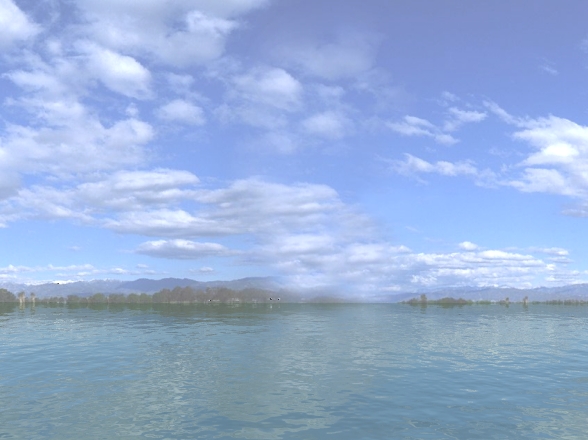Renderosity Forums / Vue
Welcome to the Vue Forum
Forum Moderators: wheatpenny, TheBryster
Vue F.A.Q (Last Updated: 2025 Jan 24 7:34 pm)
Subject: Walden Pond
Attached Link: http://www.renderosity.com/viewed.ez?galleryid=131656&Start=1&Sectionid=3&WhatsNew=Yes
To see it "big sky country" style, go to the link above... :)Thanks John... Thanks Mike, yeah, I tried a couple of things, but I figured since it got looking kinda nice, leave it at that, cause there is a light behind it, but that's a good idea, playing around more with the shadows... Also, changing the ambient settings on the plane will give brighter or duller results... There are a lot of possibilities.. :)
It's wonderful, Paul! I hope to be able to try some sky alpha planes sometime soon, too. Yves, it is basically just an image object. The "alpha plane" object is new for v.4 and all it does is automate portions of the process. But definitely you can follow the process in v.2. Create a plane object, then open the Material Editor. On the color tab, select mapped image, then navigate to the prepared image you want to use. Move to the Transparency tab, set the slider to 100% transparency and mark the box for "variable". Then to the right, the variable function will appear. Right-click the function and select "Edit Function". In the new function panel select "mapped values" and the picture option will appear. Click the Picture button and navigate to where you stored the prepared alpha image. The plane object will need to be set up to face the camera, and may need to be rotated if the image appears backwards. Also, in v.2, beware the Blue Gunk -- if you have too many transparencies in a scene, the portions that are meant to be transparent will begin to appear blue rather than clear. There are some tips for working around this in the Archive Tips collection in our forum Annex area. Have fun! :)
I had not understood, now it's OK. Thanks :) What you described is a sort of image mapping. This is not an easy thing, even for simple objects. I use UVmapper even for square or rectangle objects. But Tradivoro your image is very impressive, and I guess what definition you used ? Is it sufficient to take normal definitions (600x800) or to take higher, does it depend to the distance of the camera ? I will try this in my future "works". I am so tired with my image looking like image :) Yves
Attached Link: http://www.renderosity.com/messages.ez?Form.ShowMessage=534421
Higher definitions work better, but I've done a lot of work with 72 dpi and it definitely works as an alpha plane... This is a large one, definitely... For stuff like this, probably the larger will work better... In small stuff, like individual objects, samller resoutions work fine.. for instance, if you go to the link above, you can see a picture I did in painter.. That's 72 dpi, 500X500 and it works just fine... another thing is, for skies, you don't have to use the technique outlined by varian above, you just have to bring in the picture of the sky on a regular plane, and then just vary the transparency and the ambient setting till it blends in with the scene.. The background sky should be a very light blue, and just play with that color until you get something that blends altogether... if you want to bring in individual objects, the technique outlined above by Varian works... For further pictures and illustrations go to http://www.multimania.com/arte/beginners/bitmap.html Guitta has an excellent tutorial for Vue 2Oh, and I left out an important step....for an image object's material, be sure to check "Object Space" at the top of the editor window for that material. Otherwise the image will multiply repeat across the plane. "Object Space" will set it to show once on the plane. Okay, better late than never. :)
Privacy Notice
This site uses cookies to deliver the best experience. Our own cookies make user accounts and other features possible. Third-party cookies are used to display relevant ads and to analyze how Renderosity is used. By using our site, you acknowledge that you have read and understood our Terms of Service, including our Cookie Policy and our Privacy Policy.






This is an exercise in alpha planes, as I was experimenting with skies for the January Challenge... This was really inspired by a tutorial by Paul Papathan of 3dcommune... It originally was for bryce, and it was bringing in a sky, mapping it to a symetrical lattice, applying the sky texture to a symetrical lattice... It works beautifully in Bryce... But, guess what??? Vue's symetrical lattice won't work for this... :) Just like mapping to the terrains requires incredible math to map the image, the same thing happens with the lattices... Anyway, so the sky was brought in as an alpha plane and then positioned so that it would balance with the Vue sky and the water... Also, it was made semi transparent... You could never get skies like these in Vue... So, when you need a sky like this, find yourself a picture and bring it in... :)